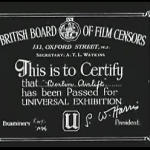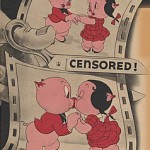I was speaking with a friend recently about film classification, notably about what a double-edged sword it has been and continues to be. But first some background…
You will recall that the official censor within the UK was at one time the Lord Chamberlain, a man (for they were all men) of rank and status, who, from 1737, had the authority to veto plays for production by denying them a licence to perform. Traditionally the reason for so doing was political, where anything deemed to be seditious could be prohibited. However, from 1843 he could only prohibit the performance of plays where he was of the opinion that “it is fitting for the preservation of good manners, decorum or of the public peace so to do”. This power caused the musical Hair to be delayed, its crime being on stage nudity, though this led to the abolition of this responsibility, courtesy of the Theatres Act, 1968. The times, they were a-changing.
The equivalent censorship of film, via the British Board of Film Censors rather than an arcane title, existed from 1912, though comparatively recently it has been given the fluffier name of British Board of Film Classification (BBFC), while America had the Hays Office for achieving the same effects between 1922 and 45, though a “voluntary code” was adopted from 1966.
For these purposes I’m going to ignore any of the unusual and unnecessarily censorious decisions made before the 70s and think instead of what has happened in my adult lifespan. The 70s and 80s were very definitely a different age, innocent in so many ways: Morecambe and Wise were seen in bed together on primetime TV, without any homosexual overtones. But it was also the era of Mary Whitehouse and James Anderton. Anything deemed to be obscene resulted in confiscation, arrests and moral outrage. While this typically meant anything other than soft core pornography, there were similar attacks on the so-called “video nasties” – though it was often possible to find quite explicitly violent horror movies at cinemas. Films were routinely banned for a variety of reasons, not least Monty Python’s Life of Brian, because some local authorities deemed it to be blasphemous.
In hindsight, some of these decisions seem bizarre. One small example: the original Video Nasty list included a movie called Dead and Buried. I saw this at a cinema in Nottingham in the early 80s (this being the same Nottingham council which also banned LoB, necessitating a trip to Loughborough to see arguably one of the funniest movies of all time.) Dead and Buried is a very creepy horror film, effectively a zombie film from a slightly different perspective. It’s no masterpiece but it’s quite well done.
Did it deserve an outright ban? Apparently the censors realised the absurdity of this ruling, since the movie was dropped from obscenity charges and removed from the DPP’s list in 2004. Why was it there at all? In hindsight it would appear that many movies went way beyond that shock factor, even at the time. If it did deserve a ban, then so did George Romero’s Dawn of the Dead, released in 1978, though no such restriction was applied to that film!
So here we get to the nub: is it ever right to curtail freedom of speech, for one person or a committee to determine what we should or should not be allowed to watch? In the cinema, nobody is forced to go, though those movies that push at the boundaries will clearly win greater attention than those playing it safe. Maybe there are things we should never be allowed to see, though whether anyone other than we ourselves should be the judge of that is a different decision. At least things are better here than countries where the government routinely bans or censors all manner of harmless entertainments, but we judge the standards applied in the context of our own society alone.
Bad Taste was a movie widely reviled but commonly available, though nobody was or is forced to see it, nor have I ever had the inclination so to do, but patronising me by suggesting I can’t apply my own self-censorship rather than thinking someone else knows better than I do is in my view unacceptable in a civilised society – providing nothing portrayed actually required the law to be broken.
All film-makers want controversy, since that will boost viewing figures and therefore profits – who can blame them from trying to be outrageous, even if that has its risks? At least you hope none will be arrested, unless they go too far for society’s expectations.
Clearly in the Internet age much has changed. Since all the sex and horror you could ever want to see is available on the web, 2011 is much more about self-censorship – ensuring that you determine your own boundaries, and those of your kids. The key issue then becomes not what is depicted in the movies but what is REAL – sex, death, the lot.
The other issue I’ve often encountered in movie censorship is the inconsistency of standards. For example, The Dead Zone is a movie directed by veteran horror stalwart David Cronenberg, starring Christopher Walken, based on a Stephen King story, which I originally saw at the cinema with my parents. In itself it is a thriller about a man who awakes from a coma realises he psychic powers. In the plot he realises the identity of a serial killer and finds a way to influence that killer to commit suicide. His means of doing so shown on the screen was unnecessarily graphic and disturbing, out of keeping with the rest of the movie, and has been notably cut from all TV showings ever since. Arguably, it should have been edited more closely to begin with, but was not cut during the classification process and awarded, as I recall, a AA certificate, thereby allowing 14 year olds to see the movie. This struck me as a curious anomaly at the time, one example where judicious editing would have improved the original movie.
This is of course but one example of many, demonstrating that the censor’s art is very inexact. Other films have been disturbing and have caused controversy, but the most notorious (A Clockwork Orange) was withdrawn by its director, Stanley Kubrick, until after his death, the irony being that its theme is anti-violence. Somehow, context, the critical factor for many of these decisions, seemed to elude the Daily Mail brigade, and often the censors too.
This brings me on to film certifications. The point of them is to protect people at a vulnerable age from seeing things deemed inappropriate for their age banding, which does not necessarily imply they are films you would want someone to see but does follow carefully defined criteria (see below.) Two points of interest here:
Firstly, studios target a particular audience and therefore gear their film to a certificate. They may voluntarily cut a movie in order to gain their desired rating and thereby optimise their audience. Films are routinely edited for display during air travel and TV, for example. Whether these cuts are essential is possibly in the eye of the beholder, but at least they aren’t swingeing cuts imposed arbitrarily, impacting on the viewer’s entertainment.
Secondly, what is deemed acceptable has changed considerably over time, possibly but not entirely in line with the changing mores of society. What was acceptable only in an X-rated movie in the 1980s might well find its way into a 12A (see below.) It’s not unknown for these films to have the occasional f-word, possibly reflecting the fact that use of such Anglo-Saxon language is more common and therefore acceptable, where once it would have been censored even in X-cert movies for adults. Where in 1959 Room At The Top was a milestone for being erotic without being explicit, sex and at least partial nudity seem common in comparatively mainstream movies. Less embarrassing for kids too, apparently! When I was a teen, the promise of a bare breast in a film was enough to get teenage boys flocking in, not that you would ever discuss that with parents!!
Where do you draw the line? Do you bother? It seems the work of the BBFC is more complex than ever, possibly even pointless. You pays your money and you takes your choice… hopefully.
Film Ratings
The current ratings are thus, and apply to cinema, DVDs and video games:
| Symbol | Name | Definition/Notes |
|---|---|---|
| Universal | All ages admitted, there is nothing unsuitable for children over 4. | |
| Parental Guidance | All ages admitted, but certain scenes may be unsuitable for children under 8. | |
 |
12A | Cinema only. Introduced in 2002.Films under this category are considered to be unsuitable for very young people. Those aged under 12 years are only admitted if accompanied by an adult, aged at least 18 years, at all times during the motion picture. However, it is generally not recommended that children under 12 years should watch the film. Films under this category can contain mature themes, discrimination, soft drugs, commonly used milder swear words, and moderate violence/sex references. |
 |
12 | Home media only since 2002. 12A-rated films are usually given a 12 certificate for the VHS/DVD version unless extra material has been added that requires a higher rating.Nobody younger than 12 can rent or buy a 12-rated VHS, DVD, Blu-ray Disc, UMD or game. Films in this category may include infrequent drugs, infrequent use of strong language, brief nudity, discreet sexual activity, and moderate violence. |
 |
15 | Only those over 15 years are admitted.Nobody younger than 15 can rent or buy a 15-rated VHS, DVD, Blu-ray Disc, UMD or game, or watch a film in the cinema with this rating. Films under this category can contain adult themes, hard drugs, strong language, moderate-strong violence/sex references, and mild non-detailed sex activity. |
 |
18 | Only adults are admitted.Nobody younger than 18 can rent or buy an 18-rated VHS, DVD, Blu-ray Disc, UMD or game, or watch a film in the cinema with this rating. Films under this category do not have limitation on the bad language that is used. Hard drugs are generally allowed, and strong violence/sex references along with strong sexual activity is also allowed. Scenes of strong real sex may be permitted if justified by the context. |
| Restricted 18 | Can only be shown at licensed cinemas or sold at licensed retailers or sex shops, and only to adults, those aged 18 or over. Films under this category have material the BBFC does not allow for its “18” rating, thus the violence and sex activity will be stronger in R18-rated VHSs, DVDs and films than those rated “18,” however, there is still a range of material that is often cut from the R18 rating. More cuts are demanded in this category than any other category.[6] |









I’m curious to find out what blog system you are using? I’m experiencing some small security problems with my latest blog and I’d like to find something more safe. Do you have any solutions?